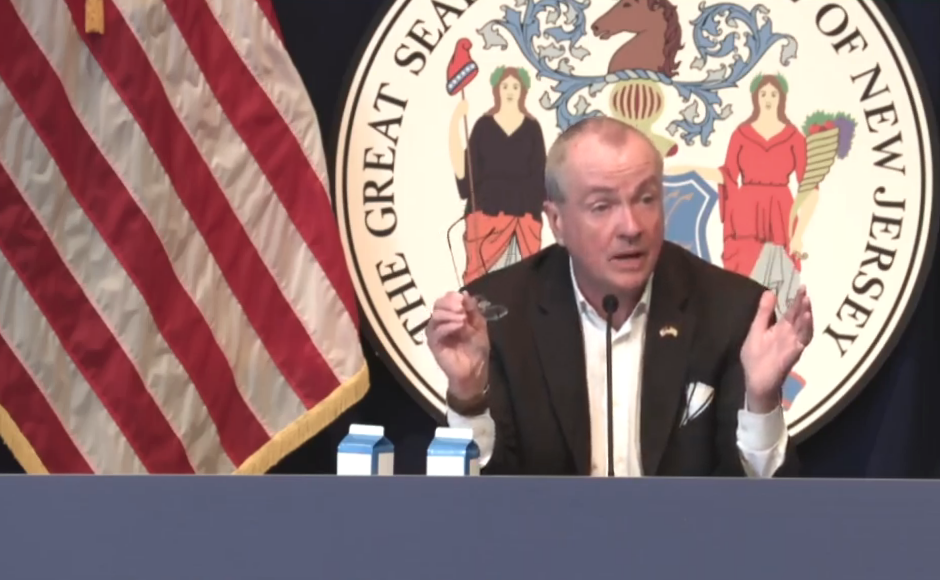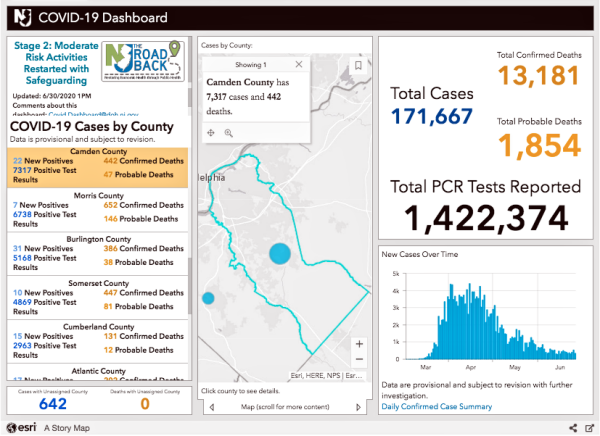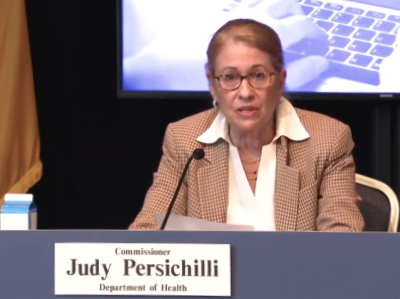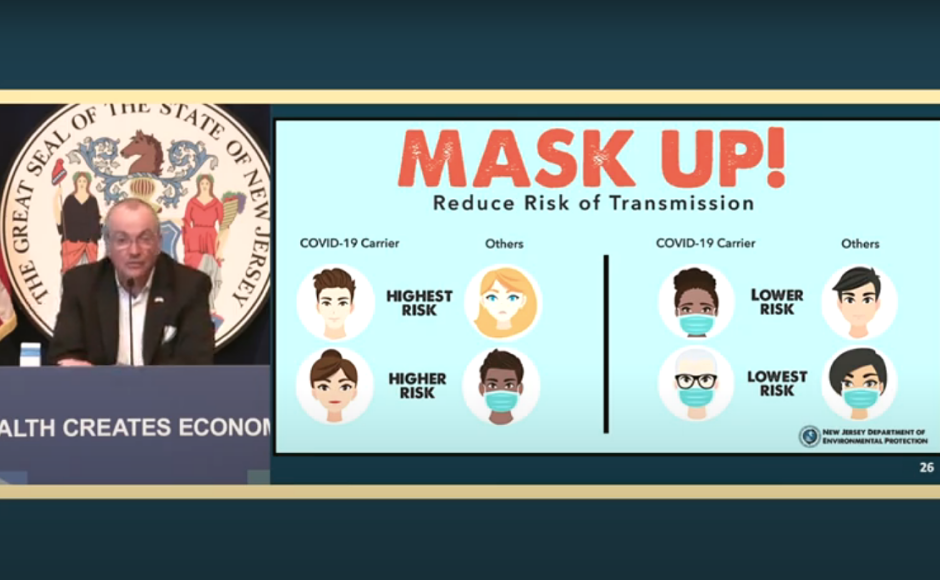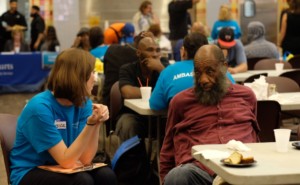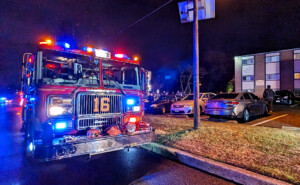Plus: the list of states from which travelers arriving in New Jersey must quarantine is updated to 16, and another child has been stricken with pediatric multisystem inflammatory syndrome, for a total of 48.
By Matt Skoufalos | June 30, 2020
Another 461 New Jersey residents have tested positive for novel coronavirus (COVID-19), bringing the statewide total to 171,667 cases, Governor Phil Murphy reported Tuesday.
New cases have been cut by 95 percent from their mid-April peak, Murphy said, while encouraging residents to continue getting tested.
Sadly, 47 more residents have perished from complications related to the virus, bringing the statewide death toll to 13,181 lives lost during the pandemic.
In addition to those lab-confirmed fatalities, the state also recognizes another 1,854 probable COVID-19-related deaths.
Throughout New Jersey, 992 people are hospitalized with a case of COVID-19, or while awaiting confirmation of their symptoms. Among those patients, 211 are in intensive or critical care, and 174 of ICU and critical-care patients (82 percent) are on ventilators.
Overnight, 44 New Jersey hospitals admitted 59 new COVID-19 patients, and 50 others were discharged, either to a lower-acuity care setting or to their homes.
Rate of transmission (Rt) up
The statewide average of COVID-19 spot positivity testing stood at 1.82 percent June 26; in South Jersey, it’s almost double, at 3.36 percent.
Rt, or the estimated rate of transmission of new cases of the virus, was 0.88 percent on June 28, up 0.02 from day-ago readings.
That figure indicates that every person infected with COVID-19 is infecting less than one other person, on average. However, it has continued to climb steadily from a low of 0.62 recorded on June 9.
Long-term care accounts for almost half of all deaths, a fifth of those infected
Across New Jersey, 557 long-term care (LTC) centers have reported at least one case of COVID-19, and account for 36,363 infected patients and staff, or 21 percent of total cases.
That includes 24,139 residents and 12,224 staffers sickened by the virus, as well as 6,423 lab-confirmed resident deaths (49 percent of the statewide total) and 117 facility-reported staff deaths.
Of 654 veterans residing in a state-run home, 386 residents have tested positive for COVID-19, and 146 have died from complications related to the virus. Seven veterans presently are hospitalized with COVID-19, and 236 have recovered from the virus.
At state-run psychiatric facilities, 211 of 1,237 patients and 498 staff members have tested positive for COVID-19. Seven staffers and 13 patients have died from complications related to the virus.
One more case of COVID-19-related pediatric illness, DOH works to isolate vulnerable residents
To date, 48 New Jersey children, aged 1 to 18, have been diagnosed with pediatric multisystem inflammatory syndrome, New Jersey Health Commissioner Judy Persichilli said, announcing one additional case Tuesday.
All have tested positive for an active COVID-19 infection or the presence of COVID-19 antibodies, indicating exposure to the virus. Eight children are still currently hospitalized. No deaths have been associated with this syndrome in New Jersey.
Persichilli also said that New Jersey has secured nearly 3,000 beds for those who need to isolate and quarantine, and either can’t do it at home, or are already homeless. These spaces include hotels that have been shuttered and the Atlantic City field medical station, which is currently housing 14 people.
Most important is ensuring that those entering isolation and quarantine have access to social services as needed, she said.
‘Cuts and uncertainty’ in $7.632-billion, three-month NJ budget
On Tuesday, Murphy signed into law a $7.632-billion spending plan that will take the state through the summer and into the beginning of fiscal 2021 (October 1, 2020).
Almost unchanged from the supplemental budget Murphy proposed at the end of May, the revisions de-appropriate almost $1.2 billion in previously approved spending, cuts some $850 million in new spending proposed in the budget as introduced in February 2020, and defers billions of state payments until the fall.
“In the most essential terms, this three-month plan can be described in two words: cuts and uncertainty,” the governor said, “and it contains plenty of each.”
Murphy described those cuts as a 5-percent, “across-the-board reduction” in non-salary operational costs and a 10-percent reduction in discretionary grants. In a statement, he reviewed specific cuts:
- Community Affairs: Delays September payments for Consolidated Municipal Property Tax Relief Aid (CMPTRA) and Energy Tax Receipts (ETR) until October.
- Education: Continues to implement the school funding formula designed in partnership with the Legislature without any additional funding over FY 2020; delays the September 22nd school aid payment into October; and defers the September school choice payments.
- Health: Provides the same overall funding for hospitals as the first quarter of FY 2020 (Charity Care, Graduate Medical Education); however the distribution may vary because funding will be allocated based on FY 2021 data.
- Labor and Workforce Development: Includes $3.875 million to modernize unemployment processing.
- Higher Education: Maintains tuition assistance programs for post-secondary students—including Tuition Aid Grants, the Educational Opportunity Fund, and Community College Opportunity Grants—at their FY 2020 funding levels. Also includes $52 million in operating aid for senior public higher education institutions and almost $14 million in operating aid for community colleges.
- Transportation: Does not include any state subsidy for NJ TRANSIT due to $1.4 billion in federal CARES Act funding being provided to the agency.
- Treasury: Does not include Senior Freeze or Homestead Benefit payments and delays the September pension payment into October.
The plan will leave New Jersey with a $956 million surplus through September 30, even after transferring $421 million from the state “Rainy Day Fund” to the general fund.
But the governor said the state “must have the ability to borrow” to offset the impact of the pandemic, which he likened both to the economic devastation of the Great Depression and the Civil War.
“We cannot just cut our way forward,” Murphy said.
Murphy defends indoor dining move, adds new states to quarantine list
The governor’s decision to “pause” the reopening of indoor eateries, even at 25-percent capacity, drew loud complaints from the state’s beleaguered restaurant and bar businesses.
Despite professing his “enormous sympathy for what that industry is going through,” Murphy said all enforcement options are “on the table,” including the revocation of liquor licenses for those entities that don’t hold the line with their customers.
“It is the reality of this virus,” he said. “Indoors, if it’s sedentary, if it’s lacking in ventilation, if you’re in close proximity, whether you’re in a bar or a restaurant setting, it is dramatically more lethal. It’s just a different reality.”
On Tuesday, New Jersey also expanded the list of states from which arriving visitors must quarantine for two weeks until they can pass a negative COVID-19 test.
- Alabama
- Arizona
- Arkansas
- California
- Florida
- Georgia
- Idaho
- Iowa
- Louisiana
- Mississippi
- Nevada
- North Carolina
- South Carolina
- Tennessee
- Texas
- Utah
As Persichilli explained last week, when the travel advisory was announced, states make the list if they show COVID-19-positive test rates higher than 10 infected people per 100,000 residents, or 10-percent-or-higher positivity rates over a seven-day rolling average.
Anyone arriving from those places to New Jersey is asked to self-quarantine for 10 days, and New Jersey residents are not exempted from it if they return home from a COVID-19 hotspot state.
Travelers can seek a COVID-19 test when they arrive in New Jersey, but should self-quarantine until they get their test results. Those who test positive should self-isolate for 10 days, including three days after any fever subsides.
Workers in “critical infrastructure” are exempted from the quarantine, Persichilli said, including truckers and transportation workers.


